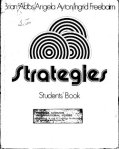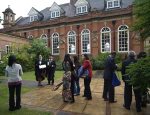Having been trained in what might best be described as late-flowering audiolingualism, it was not until my second year of teaching that I became aware of Communicative Language Teaching (CLT) and how it represented such a radical shift from current methodology. I think it must have been the influence of the Strategies series (Abbs et al. 1975) but before long everything went functional-notional, information gap activities were the rage, and formal accuracy, along with error correction, went out the window. Bliss was it in that dawn to be alive! In fact, the advent of CLT coincided nicely with my own disenchantment with drilling and with the snail-like progress through the structural syllabus that seemed only to thwart the latent fluency of my (Egyptian) students.
So, what did we gain? The emphasis on language’s social function, including attention to appropriacy and register, was important, not least because – to practise ‘being social’ with language – we needed to include lots of interactive activities, such as role plays and ‘real’ conversations, into our classes. This in turn led to the idea that (perhaps, just perhaps) such activities, rather than being simply practice of previously presented language items, could be the springboard to learning itself: that is to say, that you could learn a language simply through using it. This, after all, was a core tenet of the ‘strong’ version of CLT and was an extremely powerful idea (captured in the term ‘fluency-first), influencing all my subsequent thinking on methodology.
What we lost, from the benefit of hindsight, was a ‘focus on form’. Even if you can learn a language by using it, you still need to have your attention directed to the language’s formal features, if only so that you are ‘primed’ to notice them in situations of real language use. That realization prompted my first ever IATEFL talk, which was called ‘No pain, no gain’.
But what we also lost was the communicative approach itself. I still believe that CLT was ‘betrayed’ in the mid-1980s by the revival of the grammar syllabus and the associated drift back to an accuracy-first methodology. (A subsequent talk of mine on this topic was called ‘Not waving but drowning’). I also believe that it is possible to combine a fluency-first methodology with a focus on form, so long as that focus is primarily reactive, not pre-emptive. I’ve been lucky enough to see this occur myself, in classes I’ve observed. And, of course, the view that language learning is both an emergent and scaffolded phenomenon is fundamental to what was to become Dogme ELT. Dogme ELT was really an attempt to inject new life into CLT.
So, is Dogme ELT the future of CLT? I doubt it, somehow. The commodification and marketization of education, including language education, continues unabated. Where the language English is just another curriculum subject, where it is viewed as knowledge to be learned rather than a skill to be activated, and where it is measured less by communicative competence than by the results of high-stakes testing, then there is not a lot of incentive for a fluency-first approach. In such an educational climate, concepts so fundamental to CLT as authenticity, fluency, discovery and collaboration seem outmoded, or, at best, ‘add-ons’ for those who can afford the luxury of small classes of communicatively-motivated learners. Given the appeal that still attaches to the word ‘communicative’, though, CLT will probably continue to prosper as a brand, even though its original ingredients may have long since been reconstituted.
Abbs, B., A. Ayton, A., and I. Freebairn. 1975. Strategies: Students’ Book. London: Longman.
This was my ‘half’ of the conversation with Jeremy Harmer that we ‘performed’ at the IATEFL Conference in Harrogate in April 2014, and which is written up in IATEFL 2014 Harrogate Conference Selections, edited by Tania Pattison (Faversham, Kent: IATEFL 2015).
And here is a video of the conversation when it was first aired, at The New School, NY, in July 2013:








Recent comments